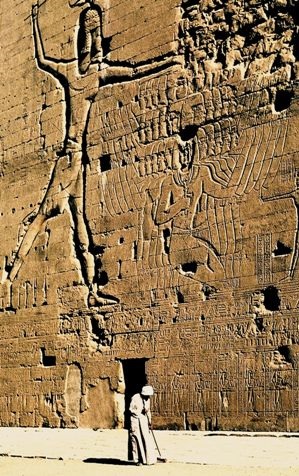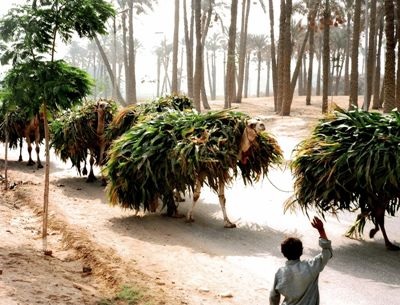
Silently and with short regular strokes his broom fell across the stone avenue – his stooped shoulders displaying none of the grandeur of his royal ancestor, his mind focused on more mundane things than the expansion of empires, national security and keeping the treasury full of foreign tribute. A couple of times, he glanced up at me as my shutter clicked away and then he went back to his work, assuming I was photographing the monument and not giving any thought to him, the living man sweeping the street.
Egypt is in many ways a country suspended between several millennia. There is the ancient Egypt which is the polytheist engine of the modern economy that keeps tourists and their money flowing into the country coffers. Then there is the modern, secular, predominantly Muslim Egypt – which you have to work hard to experience on most tours because it is hidden in plain sight. If you plan to travel to Egypt, make sure you allow time to get out to the streets and markets or take an evening dinner cruise on the Nile to get a taste of modern Egypt and modern Egyptians who aren’t hawking their imperious, imperial past. Sure, the Solar Boat and Abu Simbel are miraculous relics that are wonderful to behold – but they lack a pulse just as much as the venerated royal mummies do and remain preserved relics of a bygone era. Try as well to see the glorious spiral, lantern chandelier that hangs like a celestial whirling dervish above Cairo’s Great Mosque, and rise to the call to prayer if only to hear the chorus and feel the power of voices echoing in the streets below your hotel balcony. That is Egypt – now.

Since a few centuries before the Common Era, Egypt has been ruled by Greeks, Romans, Turks, French, and British – only to find liberation half-way through the 20th Century. Throughout the Pharonic period and into Greek, Roman and Early Turkish rule, Egypt was an important end-destination for Silk Road goods. In fact, it was the trade of cinnamon to Egypt that helped made Sri Lanka a fabulously wealthy country several millennia past.
Likewise, modern Egyptian cuisine bears the marks of these ruling nations and predecessor civilizations in a wonderfully unique way. In many ways, the Egyptian table is an umma of food from surrounding nations sharing some commonalities with Levant food, a few specialties with North Africa, and cherry-picking a few select dishes from Turkey and the Arabian Peninsula as well. For example, a meal might include some form of stuffed grapleaves and babaganoush now found from Armenia to Syria, some feta cheese and olives as appetizers and snacks, breads such as a flat and hard lavash or a softer pita, a main dish of meat and fruit cooked in a pyramidal-shaped tagine as they do in Morocco and other N. African countries, rice or a pilaf, and a dessert called basbrisa which for all intensive purposes is Egypt’s version of a western or central Asian ravane. Other desserts are dates and figs, rolled and stuffed with nuts and, my favorite beverage – spiced sumac tea. So the mark of the Silk Road’s globalization of cultures is to be found in Egypt as well.

I love Egypt, both the ancient and the modern, and hope to return someday. I love how people come in couples or with the family to have lunch and enjoy a view of the city from the Great Pyramids of Cairo. I love how some guides try to make an extra buck by trying to convince gullible tourists that they knew them in another lifetime. I love the chaotic markets and swirling streets of the metropolitan areas that give way to a world, with a quiet, gentler pulse just a few miles beyond the city limits. That’s where I took this photo of the boy bringing his family’s crop of sugar cane to the market – a few miles outside of Cairo. What I found difficult to tell when I took the picture was whether the wave of his hand is intended to urge the camels forward with their burden of cane, or whether it was intended to bid farewell to an ancient way of life that is a fading atavism in a world moving too far and too fast in the opposite direction. (Words and all photographs by Laura Kelley).

I used to bring in a photojournalist as a guest speaker every year. I called him the “Egypt Guy.”
In the auditorium, students were fascinated when he would regale them with stories of ancient and modern Egypt and his back pack adventures to exotic and distant lands. He also brought in a huge collection of toys and curiosities from his many world travels. Students in smaller groups then could interact with Michael in the library about his life and his travels.